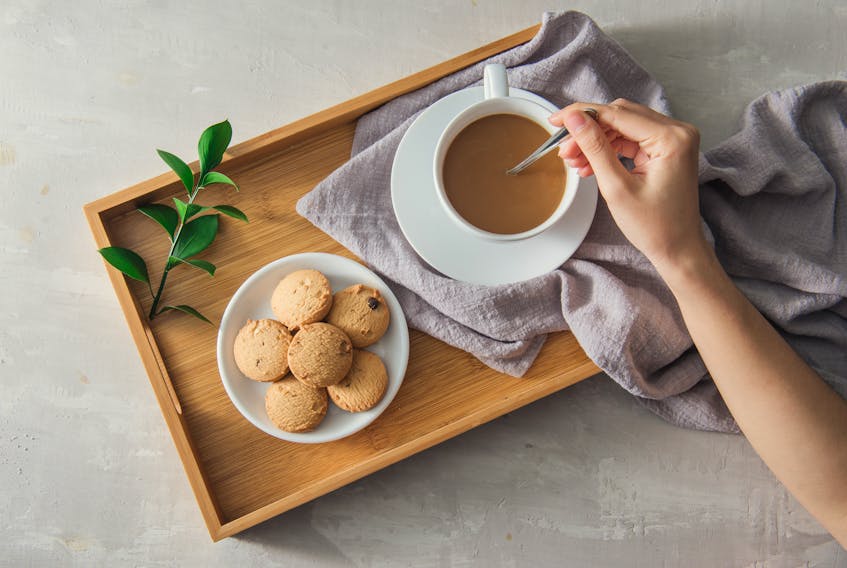
Years ago, when I took a course called Institutional Food Management, Dr. Elizabeth Upton taught a section on emergency feeding, or disaster feeding. I don’t remember the exact title of the unit, but I do remember some of the content.
One of things she taught us was that when people are troubled during crisis situations, offering a hot drink, nothing fancy, just coffee, tea or hot chocolate, and a little snack is a simple, calming gesture.
I think this applies to what we are experiencing now, and I also think that people intuitively do this, serving tea and cookies while sitting things out at home.
Baking is a creative activity, a distraction from worrisome news, and when you’re finished, you can sit down to a tasty snack. It doesn’t solve the big problems, but it can be relaxing. Those with medical conditions like diabetes need to be more careful in choosing their snacks, but the principle is the same.
This week I’m baking my mother’s recipe for Thimble Cookies. Essentially, it’s a shortbread-type dough, rolled into balls, with a depression that is filled with jelly after the cookies are baked.
If you don’t have a thimble, be creative. These are also called thumbprint cookies.
Thimble Cookies
- 125 mL (½ cup) butter
- 50 mL (¼ cup) sugar
- 1 egg, separated
- 5 mL (1 tsp) vanilla extract
- 250 mL (1 cup) all purpose flour
- finely chopped nuts or crushed bran flakes
- jelly
Preheat oven to 180 C (350 F).
Separate egg.
Cream butter. Add sugar and mix well. Beat in well-beaten egg yolk and vanilla. Stir in flour until well-combined.
Shape dough into balls. Dip each in unbeaten egg white, and then in chopped nuts or crushed bran flakes. Dent the centre of each ball with a thimble, and place on greased cookie sheet.
Bake at 180 C (350 F) for 5 minutes. Remove from oven, dent again, and bake 12-15 minutes longer.
Fill hole with jelly while still warm.
Another thing I learned from Upton is that predictable routines, including regular mealtimes, help us to keep an even keel during difficult circumstances. When much is changing around us, it is helpful to maintain any healthy rhythms and habits possible.
It’s worth emphasizing that this is not a time to live on tea and cookies or toast. Those have a role to play, but we need more. At a time when maintaining good health is so important, healthy eating is vital.
Meals need to include, as they do at any time, plenty of vegetables and fruit. If you are staying at home as much as possible, then you are likely relying more on frozen or canned products than on fresh produce. Whether using garden produce that you froze for yourself, or commercially frozen vegetables, you can be assured that vegetables frozen properly and promptly at peak ripeness lose little of their nutrient value. They also add flavour, colour and texture to meals.
Canned vegetables, unless processed with less or no salt, are higher in sodium than fresh or frozen ones. If this is a concern for you, you can rinse them in clear water to wash away much of the added salt.
If you are in the habit of having a glass of juice with breakfast, you might consider heeding the recommendation to replace juice with whole fruit. It may not be so easy to keep a supply of oranges or grapefruits if you are avoiding the stores, but if you are lucky enough to have berries in the freezer, they are great on their own, sprinkled over cereal, or pureed in a smoothie.
Frozen rhubarb, cooked into sauce and sweetened to taste, is another option.
Do you have dried apricots in the baking cupboard? You can cook them to serve with breakfast or any other meal. To cook, place 500 g (1 pound) of dried apricots in a heavy pan with 750 mL (3 cups) of water. 500 g of apricots is about 800 mL (3¼ cups) in volume. Simmer the apricots for about 35 minutes, and then add 125-250 mL (½ to 1 cup) of sugar. Heat until sugar dissolves, about 5 minutes. This makes about 10 servings.
Make good use of the resources you have at this time, and stay safe and healthy.
Margaret Prouse, a home economist, can be reached by email at [email protected].









